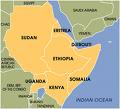The Famine in Somalia. The Use of Food as an Instrument of Warfare
U.S. and Ethiopia Kill Somalis With Food Weapon

The drought that threatens more than ten million lives in the Horn of Africa has been made vastly more deadly by U.S. and Ethiopian use of food as a weapon of war. The Americans last year forced the collapse of cooperation between aid agencies and Shabab resistance fighters in Somalia. And Ethiopia, a center of the drought, has virtually sealed off its rebellious Ogaden region from outside observers and aid providers, including the International Red Cross, in order to conceal its brutal, collective punishment of ethnic Somalis.
“The Ethiopian government has blocked the International Red Cross and other aid agencies from carrying out relief work in the region.”
At least 10 million people are in danger of starvation in Kenya, Djibouti, Ethiopia and Somalia, under the worst drought conditions in 60 years. This should be taken as fact. But when it comes to which humans are to blame for relief supplies being unavailable to the victims, don’t believe a word that the United States government says. Washington is not only the greatest purveyor of violence in the world, it is also the biggest liar on the planet, none of whose words can be taken at face value.
The Americans claim the Shabab Islamist fighters made the drought crisis worse by preventing international aid agencies from distributing food relief. But only last year, in February 2010, the New York Times was running a headline, “UN Officials Assail U.S. for Withholding Somali Aid [8].” We explored that story [9] in Black Agenda Report. Back then, United Nations officials charged the U.S. with imposing conditions that made it “impossible” to deliver tens of millions in food aid to hungry Somalis. The Americans refused to allow food to be transferred from warehouses in Kenya, claiming it might enrich the coffers of the Shabab, who controlled about half of Somalia. The U.S. finally let some food pass through, but only on the condition that aid workers not pay any fees at Shabab checkpoints around the country. Aid workers on the ground said that following U.S. orders would make them “look like spies.” Apparently, they were right.
It was a clear case of the United States using food as a weapon of war, starving the people of Somalia in order to destroy the social base for the resistance to U.S. proxy rule over the country. We do know that the relationship between the Shabab and international aid agencies fell apart, at that point, so one could conclude that Washington succeeded in its mission. Starving people are now paying the price.
“A look at the map of the drought-stricken areas shows that the Ogaden is a center of the crisis.”
The U.S.-backed puppet government in Somalia’s capital, Mogadishu, waited until this week to declare a drought emergency in Somalia. Kenya, another American puppet, refused to allow Somalis to enter a brand new – and empty – refugee camp. Ethiopia may be the worst case. Not only did it bring on what was then Africa’s “worst humanitarian crisis,” according to the UN, by invading the country in late 2006, at the instigation of the United States – Ethiopia has virtually sealed off its vast Ogaden region to outside observers, and a look at the map of the drought-stricken areas shows that the Ogaden is a center of the crisis!
The Ogaden is populated by ethnic Somalis who have been fighting their own guerilla war against the Ethiopian dictatorship, whom they charge with using food as a weapon of war [10]. Of the 10 million people at risk of starvation, a huge portion live – or are now dying – in the Ogaden. As the dependable Thomas C. Mountain reports [11] from nearby Eritrea, the Ethiopian government has blocked the International Red Cross and other aid agencies from carrying out relief work in the region. The Obama administration, which now gives the Ethiopian dictatorship more money than any regime in Africa, could force the doors to the Ogaden open with one phone call. But it won’t, because Ethiopia and the U.S. are on the same mission, and there is nothing humanitarian about it. For Black Agenda Radio, I’m Glen Ford. On the web, go to www.BlackAgendaReport.com [12].
BAR executive editor Glen Ford can be contacted at [email protected] [13].
http://traffic.libsyn.com/blackagendareport/20110720_gf_SomaliaDrought.mp3 [14]
Source URL: http://blackagendareport.com/content/us-and-ethiopia-kill-somalis-food-weapon
Notes
[1] http://blackagendareport.com/category/department-war/africom
[2] http://blackagendareport.com/category/department-war/food-weapon-war
[3] http://blackagendareport.com/category/other/ba-radio-commentary
[4] http://blackagendareport.com/category/africa/ethiopia
[5] http://blackagendareport.com/category/africa/kenya
[6] http://blackagendareport.com/category/africa/somalia
[7] http://blackagendareport.com/sites/www.blackagendareport.com/files/lets_starve_somalia_0.jpg
[8] http://www.markacadey.net/main/news.php?readmore=2695
[9] http://www.blackagendareport.com/content/us-wages-food-war-against-somalia
[10] http://www.ogaden.com/hornnews/ethiopia/1258-stop-the-regime-of-meles-zenawi-from-using-hunger-as-means-of-collective-punishment-to-destroy-the-ogaden-community-.html
[11] http://www.counterpunch.org/mountain05102011.html
[12] http://www.BlackAgendaReport.com/
[13] mailto:[email protected]
[14] http://www.addtoany.com/share_save?linkurl=http%3A%2F%2Fblackagendareport.com%2Fcontent%2Fus-and-ethiopia-kill-somalis-food-weapon&linkname=U.S.%20and%20Ethiopia%20Kill%20Somalis%20With%20Food%20Weapon

